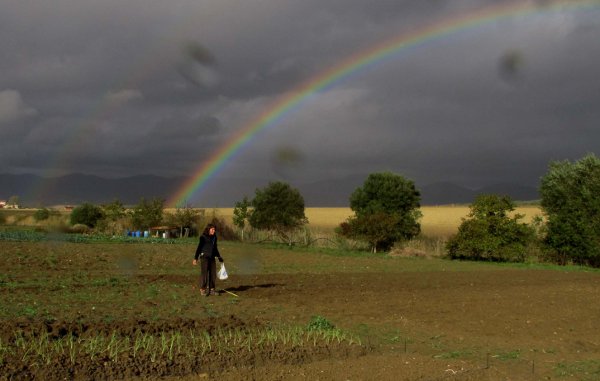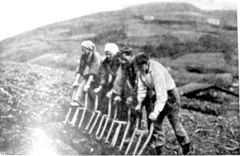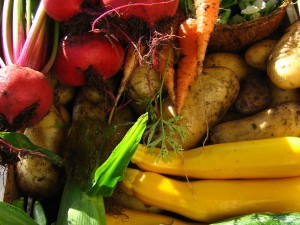
Soil management is a big subject. It seems to require the balancing of; drainage, crop rotation, enriching with compost and turning mechanically. It can be approached as a science or an art because it consists of both.
There are many schools of thought and I am not an expert in any. Of the many bits and pieces I have read on the subject, Permaculture is the approach which seems to make most sense to me in terms of soil ecology and the sustenance of a healthy garden. Apart from the fact that it seems to make sound ecological sense I am quickly sold on the merits of its design.
Permaculture gardens are built to be worked easily. They are about not over-reaching yourself in your grand design. Nature doesn’t struggle and neither should you in your efforts to nurture it. Some hard labour is required nonetheless. Soil has to be dug and raised beds, a key feature of the permaculture garden, need to be created.
There is no doubt that mechanical assistance in the form of a rotavator or donkeys if you have them, is essential in creating a decent system of raised beds. The beds can be as long as you like but must not be wider than your reach with a hoe. Consequently, you never walk on the earth so it never becomes compacted and you will never need to dig them over again. You will however need to break up the soil at the end of the growing season and for this there is no better tool than the “lay
a” pronounced /Lie a/ as in, “Liar, liar pants on fire”.
The laya was widely used in Euskal Herria (The Basque Country) until the early part of the last century when the Basque farmers threw them away in favour of mechanised, industrial-agriculture with its “easy life” promises. It would appear that the sales rep that sold us that idea may have had his pants on fire though.
 Layas come in many shapes and forms but are essentially a row of sharp prongs connected to a double handle. The prongs are driven into the soil and the handles are used to lever it back thus opening up the ground. There are two sets of benefits to the laya. Firstly, it’s easy to use. It’s “ergonomics” are close to perfect. Secondly, it’s tremendously beneficial to the soil.
Layas come in many shapes and forms but are essentially a row of sharp prongs connected to a double handle. The prongs are driven into the soil and the handles are used to lever it back thus opening up the ground. There are two sets of benefits to the laya. Firstly, it’s easy to use. It’s “ergonomics” are close to perfect. Secondly, it’s tremendously beneficial to the soil.
ergonomics
The laya should be a comfortable weight for you to work with but heavy enough to allow you to use that weight to drive the prongs into the ground. The handles should be level with your hips when the prongs are fully immersed in the soil. So, adopting an upright position, you drop the prongs into the earth, step onto the cross bar and allow your weight to press them home. A step back and you’ve effortlessly levered the prongs up through the soil. Raise the laya, plunge, step back, lever, breathe… No back ache the next day!
See this video of someone using a laya
healthy soil
The soil benefits because the laya penetrates much deeper than the rotavator. Rotavators are great for initial preparation but their repeated use tends to create a hard and impenetrable cap below the light top soil. The laya does not turn the earth over but rather breaks it up improving structure, water penetration and retention. Micro-organisms whose role it is to process nutrients and minerals therefore perform better and ensure that the soil is good and fertile when it comes to the plants we want to encourage.
Let’s be clear about a couple of things.
It is entirely understandable that the impoverished and hard-working Basque farmer along with numerous others around the world, exchanged their layas for a warm seat in a tractor. The possibility of producing more and working less is always very enticing. However this economic model has led us to a perilous state of affairs in which we are handcuffed to the price of oil. This pattern of production and consumption has to change. Do we return to the ways of our grandparents? A mid-Devon councillor said Nobody would subject themselves to that way of life. You might as well be in prison.
I would respond that we are already prisoners to an oil-based economy ruled by a handful of multinationals.
What then, is the way forward?
I hope that it may be nothing more than greater collaboration between us.
The field you can see in the video is called “Sorgin Soro” (Witches Field) and is an emerging cooperative with the collaboration of many individuals. It aims to supply organic produce to a network of local consumers, who are directly involved in the food chain. There is an interaction between them and between the producers which facilitates the sharing of ideas, collaboration and the management of our collective resources.
The people who comprise this group have willingly taken a step back in time and in so doing often have to contend with living issues which others would consider hardships. We have found that the only realistic way forward is through the pooling of all our resources and collective collaboration in the realisation of our goals. Now, laborious tasks which if faced alone would achieve Sisyphean proportions, become light work and just plain fun.
getting your hands on a laya
Make one or get someone who knows how to weld to knock one up. The folks at http://floranopolis.blogspot.com.es/p/herramientas-huerteras.html have made some elegant layas out of old bicycle forks. You can also buy them here http://www.ecoprac.com/ang/index.asp
some more facts about layas

In this photo taken in around 1920 you can see a team of folk from the Basque province of Vizcaya using layas.
Hard work no doubt but I bet it was good fun at the same time. Here in Euskal Herria there is a great tradition of work in community. It even has a name “Auzolan”. I’m sure you’ll find it all over the world although you may have to dig a little. The tradition of Auzolan is perhaps more active in the villages but it’s no less alive in the cities. In recent times more and more people are turning to the
concept of Auzolan as a means of confronting and resolving the issues which they face.
The organisation Auzolan has formed in recent years and aims to facilitate communication of ideas and resources at our disposal. Coincidentally they chose an image of a group of people using layas to represent their organisation.
Viva la revolución verde eta Gora iraultza berdea!

more info on layas
How to make and use them – see here, here and here.
The views expressed in our blog are those of the author and not necessarily lowimpact.org's




 Could the ‘paperpot transplanter’ be a boon for small farmers or is it just a gimmick?
Could the ‘paperpot transplanter’ be a boon for small farmers or is it just a gimmick?
 Smallholding
Smallholding
 Soil management
Soil management
 Vegetable growing
Vegetable growing


